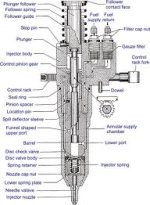rsallen
Platinum Member
What the on the unit injector test DOESN'T tell you is what the opening pressures are.
Unless you have some idea about what you're looking at the test you ran probably tells you nothing.
Why full throttle? What did the atomization of the fuel look like. What was the cone pattern? Was there any leakage after?
As you described the test and results it sounds like you should get the injectors to someone that has a tester to put them on.
I can't say that I've ever tested a diesel injector that would shoot any where near 3 or four feet, as by the time it would get that far away there'd be so little pattern left one wouldn't see any fuel.
Also could you describe exactly how you adjust the valves.
For instance, how do you determine that the top dead center on each cyl. is the compression stroke?
Unless you have some idea about what you're looking at the test you ran probably tells you nothing.
Why full throttle? What did the atomization of the fuel look like. What was the cone pattern? Was there any leakage after?
As you described the test and results it sounds like you should get the injectors to someone that has a tester to put them on.
I can't say that I've ever tested a diesel injector that would shoot any where near 3 or four feet, as by the time it would get that far away there'd be so little pattern left one wouldn't see any fuel.
Also could you describe exactly how you adjust the valves.
For instance, how do you determine that the top dead center on each cyl. is the compression stroke?

